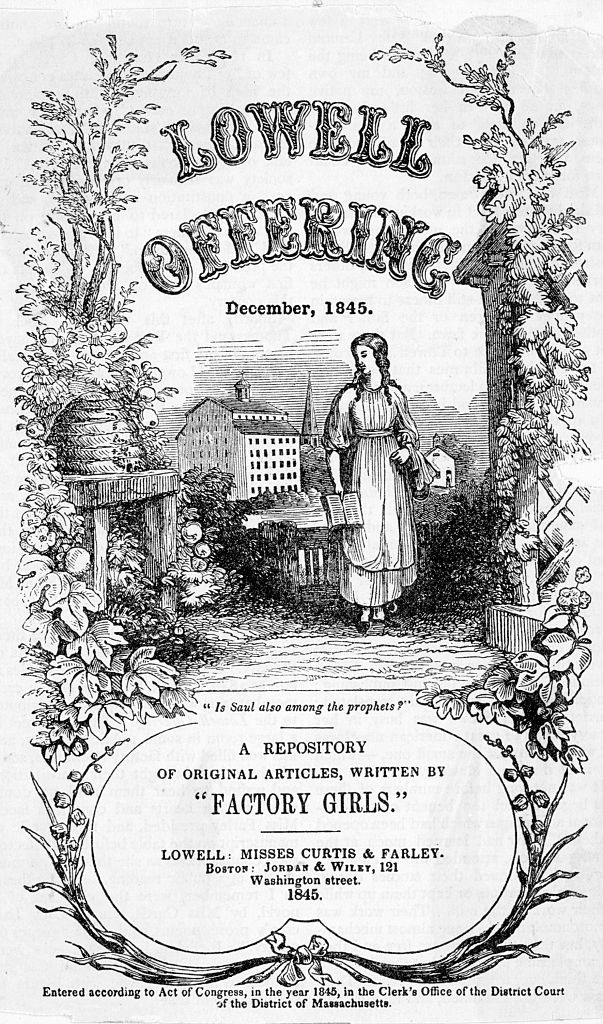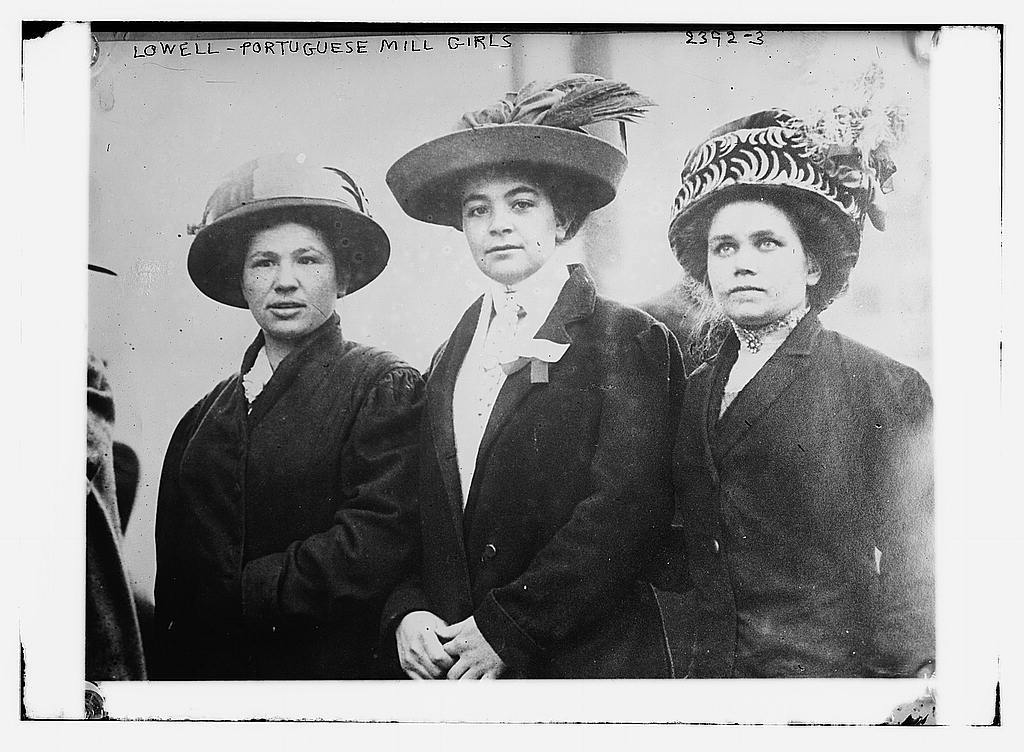It started like most revolutions do: with gossip. It was 1836, and thousands of mill workers in Lowell, Massachusetts—almost all of them women and girls—had gotten to talking. Their wages had been cut, and conditions in the factories where their work seemed to be taken for granted were deteriorating. Someone started murmuring about taking action, and then the whispers spread. There was talk of a strike. Who better to recognize the power of a little idle patter than girls?
The first textile factories opened in the United States in the 1820s, ushering in a new era in American manufacturing. Their mastermind, Francis Cabot Lowell, had imported the model from Britain, but he’d been horrified to see the barbaric conditions in which children worked on the other side of the Atlantic. He decided his workforce would be drawn from the girls of New England, and their treatment would be the factories’ point of pride—beautiful, blossoming American girls, learning, and earning amid the looms.
A decade later, most mill workers were indeed girls, some just 10 or 12. And it wasn’t all mood-boosting slumber parties and self-development—there were injuries, harassment, strict rules, and mistreatment. Weavers reported having to suck thread through the wooden shuttles that fed into the looms, with lint accumulating in their lungs. The phenomenon was called the “kiss of death”—quite a name for an affliction that befell New England’s most virtuous women and girls. Still, that all-female environment was unprecedented. It gave hundreds of girls a chance to see themselves as a cohort just as women’s education was becoming a national crusade. It let them earn a measure of independence. After hours at the mills, girls talked: traded secrets, bonded, fantasized, dreamed. Mill workers started not one, but two magazines to collect their adolescent work, including the famed Lowell Offering. De facto diaries and scrapbooks, the zines were a serious chronicle of the kind of chatter that adults still dismiss. Girls wrote about nature, their visions for their future homes and families, clothes. In a forerunner to that staple format of women’s media in which readers annotate their spending habits, an editor ran an article in the Offering in which she invited four workers to detail their uses for a week’s wages. One purchased a shawl. Another was prudent; she had opened a savings account and deposited her earnings.

When the strikes started and spread across mills in the area, it was “girl talk” that laid the groundwork. Harriet Hanson, who went to work in the mills at 11, recalled how word had traveled in the runup to their walkouts. The discontent, the sense of unfairness—what started as off-hours commiseration became fodder for something grander. Action soon followed. So it was in 1836 in Lowell, and so it would be in future revolutions: Girl talk as the lit match.
In 1951, the then teenage Barbara Johns gathered a small, co-ed group of students together to discuss the unequal conditions in their segregated school in Virginia. With a few (most of them girls), she plotted, turning the adolescent lament (“it’s not fair!”) into a school walkout that helped form the basis for Brown v. Board of Education.
More from TIME
In a school cafeteria in New York in 1968, Alice de Rivera and a friend raged about their lackluster classes and ended up hatching a plan to seek admission at Stuyvesant, which barred girls from attending. De Rivera challenged the rule in court.
A few months later, “girl talk” inspired Barbara Deck, the undergraduate vice president of a small Catholic women’s college in Boston, to host a women’s liberation conference on campus. A breakout session was titled “Women and Their Bodies.” Participants traded horror stories about how doctors had treated them, refusing to tell them how birth control—or their own organs—worked, harassing them or disregarding their pain. After that session, participants resolved to create a pamphlet based on their research and discussions that would be called Women and Their Bodies. It was later reworked as the iconic Our Bodies, Ourselves.
Johns, de Rivera, and Deck (and later, anti-gun violence activists and climate crisis crusaders) were venting about fundamental inequalities when casual conversation drove them to act. But even girls whose chitchat was never so principled grew up to see how girl talk had fueled them. It helped them practice for what was next.
In her memoir Where the Girls Are, the writer Susan Douglas remembered listening to girl groups like The Shirelles, whose music emphasized love and experimentation, and the Beatles. She obsessed over the music with her friends, a fixation that cultivated their tastes, primed them to seek pleasure and fulfillment, and allowed them to dream about what a full, liberated life could look like. The Shirelles weren’t a band of activists, but their music helped girls practice a defining element of second-wave feminism: talking. It was the first step toward, as Douglas wrote, “other freedoms as well.”
“What we have here is a pop culture harbinger in which girl groups, however innocent and commercial, anticipate women’s groups, and girl talk anticipates a future kind of women’s talk,” Douglas explained.
Such bonds—between girls, between women—serve as the foundation on which progress is built. Deborah Tannen, a professor of linguistics at Georgetown and the author of You’re the Only One I Can Tell: Inside the Language of Women’s Friendships, has seen as much in her research. She has studied the phenomenon of small talk and noted the gender divide: In general, men see it as a distraction (“just chatting”), whereas women view it as crucial.
“I make the point,” Tannen told me, “that it creates relationships that are drawn on for other kinds of work, that it creates a kind of trust, a kind of comfort, a sense of a shared life.” No wonder female activists—proficient in its arts—have been such effective mobilizers of their pals and comrades. No wonder those of us who are socialized to make-believe and fantasize have for centuries been the people dreaming of a better world. Not just the mill girls, but the girls on the vanguard of freedom movements in the United States and around the world now.
Read More: Medieval Women Were a Vital Part of the Workforce. We Can Learn from Them
In the case of Lowell, it must be said that the material victories of girl talk—and of the strikes it inspired—were limited. The protestors did not win most of their intended concessions. The girls returned to their posts or quit and moved on. The fact that mill workers were denied better conditions and more humane hours fed a more exploitative labor environment, the kind that resulted in catastrophes like the Triangle Shirtwaist Fire decades later.
But the chatter—it did make its mark.
In 1978, the historians Benita Eisler and Philip S. Foner both edited anthologies of the works of the mill girls. The women’s liberation movement was in full swing. Books about women who had stood up for themselves had an obvious audience. But so few women’s histories had ever been recorded. The mill girls—in their determination both to build a new world and to narrate their efforts in outlets like the Offering—still resonated.
“Here and there among these diversified documents we glimpse the first seeds of the . . . evolving feminist,” wrote C. David Heymann of the anthologies in The New York Times. “There is talk of sisterhood, of the need to unite, of the battle to maintain self-respect in the face of imminent defeat.” He—and it was of course a man who had been tasked with evaluating the merit of their work—called The Offering an “invaluable tool” in the envisioning of a feminist future.
The magazine had “provided its contributors, editors, and readers with a voice and sounding board where before there had been . . . a void.”
More Must-Reads From TIME
- The 100 Most Influential People of 2024
- Coco Gauff Is Playing for Herself Now
- Scenes From Pro-Palestinian Encampments Across U.S. Universities
- 6 Compliments That Land Every Time
- If You're Dating Right Now , You're Brave: Column
- The AI That Could Heal a Divided Internet
- Fallout Is a Brilliant Model for the Future of Video Game Adaptations
- Want Weekly Recs on What to Watch, Read, and More? Sign Up for Worth Your Time
Contact us at letters@time.com
